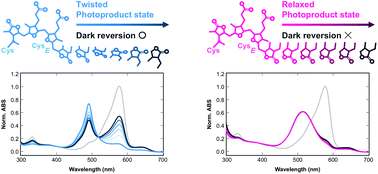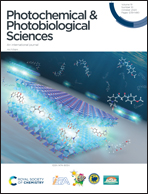A photoproduct of DXCF cyanobacteriochromes without reversible Cys ligation is destabilized by rotating ring twist of the chromophore†
Abstract
Cyanobacteriochrome photoreceptors (CBCRs) ligate linear tetrapyrrole chromophores via their first (canonical) Cys residue and show reversible photoconversion triggered by light-dependent Z/E isomerization of the chromophore. Among the huge repertoire of CBCRs, DXCF CBCRs contain a second Cys residue within the highly conserved Asp-Xaa-Cys-Phe (DXCF) motif. In the typical receptors, the second Cys covalently attaches to the 15Z-chromophore in the dark state and detaches from the 15E-chromophore in the photoproduct state, whereas atypical ones that lack reversible ligation activity show red-shifted absorption in the dark state due to a more extended π-conjugated system. Moreover, some DXCF CBCRs show blue-shifted absorption in the photoproduct state due to the twisted geometry of the rotating ring. During the process of rational color tuning of a certain DXCF CBCR, we unexpectedly found that twisted photoproducts of some variant molecules showed dark reversion to the dark state, which prompted us to hypothesize that the photoproduct is destabilized by the twisted geometry of the rotating ring. In this study, we comprehensively examined the photoproduct stability of the twisted and relaxed molecules derived from the same CBCR scaffolds under dark conditions. In the DXCF CBCRs lacking reversible ligation activity, the twisted photoproducts showed faster dark reversion than the relaxed ones, supporting our hypothesis. By contrast, in the DXCF CBCRs exhibiting reversible ligation activity, the twisted photoproducts showed no detectable photoconversion. Reversible Cys adduct formation thus results in drastic rearrangement of the protein–chromophore interaction in the photoproduct state, which would contribute to the previously unknown photoproduct stability.

- This article is part of the themed collection: The World Congress on Light and Life, Barcelona 2019


 Please wait while we load your content...
Please wait while we load your content...